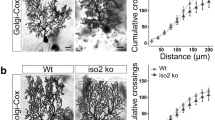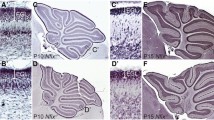Abstract
The Na,K-ATPase, consisting of a catalytic α-subunit and a regulatory β-subunit, is a ubiquitously expressed ion pump that carries out the transport of Na+ and K+ across the plasma membranes of most animal cells. In addition to its pump function, Na,K-ATPase serves as a signaling scaffold and a cell adhesion molecule. Of the three β-subunit isoforms, β1 is found in almost all tissues, while β2 expression is mostly restricted to brain and muscle. In cerebellar granule cells, the β2-subunit, also known as adhesion molecule on glia (AMOG), has been linked to neuron–astrocyte adhesion and granule cell migration, suggesting its role in cerebellar development. Nevertheless, little is known about molecular pathways that link the β2-subunit to its cellular functions. Using cerebellar granule precursor cells, we found that the β2-subunit, but not the β1-subunit, negatively regulates the expression of a key activator of the Hippo/YAP signaling pathway, Merlin/neurofibromin-2 (NF2). The knockdown of the β2-subunit resulted in increased Merlin/NF2 expression and affected downstream targets of Hippo signaling, i.e., increased YAP phosphorylation and decreased expression of N-Ras. Further, the β2-subunit knockdown altered the kinetics of epidermal growth factor receptor (EGFR) signaling in a Merlin-dependent mode and impaired EGF-induced reorganization of the actin cytoskeleton. Therefore, our studies for the first time provide a functional link between the Na,K-ATPase β2-subunit and Merlin/NF2 and suggest a role for the β2-subunit in regulating cytoskeletal dynamics and Hippo/YAP signaling during neuronal differentiation.







Similar content being viewed by others
References
Clausen MV, Hilbers F, Poulsen H (2017) The structure and function of the Na,K-ATPase isoforms in health and disease. Front Physiol 8:371. https://doi.org/10.3389/fphys.2017.00371
Li Z, Xie Z (2009) The Na/K-ATPase/Src complex and cardiotonic steroid-activated protein kinase cascades. Pflugers Arch - Eur J Physiol 457(3):635–644. https://doi.org/10.1007/s00424-008-0470-0
Rajasekaran SA, Rajasekaran AK (2009) Na,K-ATPase and epithelial tight junctions. Front Biosci 14:2130–2148
Reinhard L, Tidow H, Clausen M, Nissen P (2013) Na+,K+-ATPase as a docking station: protein–protein complexes of the Na+,K+-ATPase. Cell Mol Life Sci 70(2):205–222. https://doi.org/10.1007/s00018-012-1039-9
Pierre SV, Xie Z (2006) The Na,K-ATPase receptor complex: its organization and membership. Cell Biochem Biophys 46(3):303–316
Antonicek H, Persohn E, Schachner M (1987) Biochemical and functional characterization of a novel neuron-glia adhesion molecule that is involved in neuronal migration. J Cell Biol 104(6):1587–1595
Kitamura N, Ikekita M, Sato T, Akimoto Y, Hatanaka Y, Kawakami H, Inomata M, Furukawa K (2005) Mouse Na+/K+-ATPase beta1-subunit has a K+-dependent cell adhesion activity for beta-GlcNAc-terminating glycans. Proc Natl Acad Sci U S A 102(8):2796–2801. https://doi.org/10.1073/pnas.0409344102
Rajasekaran SA, Palmer LG, Quan K, Harper JF, Ball WJ Jr, Bander NH, Peralta Soler A, Rajasekaran AK (2001) Na,K-ATPase beta-subunit is required for epithelial polarization, suppression of invasion, and cell motility. Mol Biol Cell 12(2):279–295
Shoshani L, Contreras RG, Roldan ML, Moreno J, Lazaro A, Balda MS, Matter K, Cereijido M (2005) The polarized expression of Na+,K+-ATPase in epithelia depends on the association between beta-subunits located in neighboring cells. Mol Biol Cell 16(3):1071–1081. https://doi.org/10.1091/mbc.E04-03-0267
Vagin O, Tokhtaeva E, Sachs G (2006) The role of the beta1 subunit of the Na,K-ATPase and its glycosylation in cell-cell adhesion. J Biol Chem 281(51):39573–39587. https://doi.org/10.1074/jbc.M606507200
Barwe SP, Kim S, Rajasekaran SA, Bowie JU, Rajasekaran AK (2007) Janus model of the Na,K-ATPase beta-subunit transmembrane domain: distinct faces mediate alpha/beta assembly and beta-beta homo-oligomerization. J Mol Biol 365(3):706–714. https://doi.org/10.1016/j.jmb.2006.10.029
Gloor S, Antonicek H, Sweadner KJ, Pagliusi S, Frank R, Moos M, Schachner M (1990) The adhesion molecule on glia (AMOG) is a homologue of the beta subunit of the Na,K-ATPase. J Cell Biol 110(1):165–174
Martin-Vasallo P, Dackowski W, Emanuel JR, Levenson R (1989) Identification of a putative isoform of the Na,K-ATPase beta subunit. Primary structure and tissue-specific expression. J Biol Chem 264(8):4613–4618
Blanco G (2005) Na,K-ATPase subunit heterogeneity as a mechanism for tissue-specific ion regulation. Semin Nephrol 25(5):292–303. https://doi.org/10.1016/j.semnephrol.2005.03.004
Magyar JP, Bartsch U, Wang ZQ, Howells N, Aguzzi A, Wagner EF, Schachner M (1994) Degeneration of neural cells in the central nervous system of mice deficient in the gene for the adhesion molecule on glia, the beta 2 subunit of murine Na,K-ATPase. J Cell Biol 127(3):835–845
Peng L, Martin-Vasallo P, Sweadner KJ (1997) Isoforms of Na,K-ATPase alpha and beta subunits in the rat cerebellum and in granule cell cultures. J Neurosci 17(10):3488–3502
Wetzel RK, Arystarkhova E, Sweadner KJ (1999) Cellular and subcellular specification of Na,K-ATPase alpha and beta isoforms in the postnatal development of mouse retina. J Neurosci 19(22):9878–9889
Weber P, Bartsch U, Schachner M, Montag D (1998) Na,K-ATPase subunit beta1 knock-in prevents lethality of beta2 deficiency in mice. J Neurosci 18(22):9192–9203
Lecuona E, Luquin S, Avila J, Garcia-Segura LM, Martin-Vasallo P (1996) Expression of the beta 1 and beta 2(AMOG) subunits of the Na,K-ATPase in neural tissues: cellular and developmental distribution patterns. Brain Res Bull 40(3):167–174
Pagliusi SR, Schachner M, Seeburg PH, Shivers BD (1990) The adhesion molecule on glia (AMOG) is widely expressed by astrocytes in developing and adult mouse brain. Eur J Neurosci 2(5):471–480
Muller-Husmann G, Gloor S, Schachner M (1993) Functional characterization of beta isoforms of murine Na,K-ATPase. The adhesion molecule on glia (AMOG/beta 2), but not beta 1, promotes neurite outgrowth. J Biol Chem 268(35):26260–26267
McClatchey AI, Fehon RG (2009) Merlin and the ERM proteins—regulators of receptor distribution and signaling at the cell cortex. Trends Cell Biol 19(5):198–206. https://doi.org/10.1016/j.tcb.2009.02.006S0962-8924(09)00058-0
Stamenkovic I, Yu Q (2010) Merlin, a “magic” linker between extracellular cues and intracellular signaling pathways that regulate cell motility, proliferation, and survival. Curr Protein Pept Sci 11(6):471–484
Schulz A, Geissler KJ, Kumar S, Leichsenring G, Morrison H, Baader SL (2010) Merlin inhibits neurite outgrowth in the CNS. J Neurosci 30(30):10177–10186. https://doi.org/10.1523/JNEUROSCI.0840-10.201030/30/10177
Schulz A, Zoch A, Morrison H (2014) A neuronal function of the tumor suppressor protein merlin. Acta Neuropathol Commun 2:82. https://doi.org/10.1186/s40478-014-0082-1s40478-014-0082-1
Schulz A, Baader SL, Niwa-Kawakita M, Jung MJ, Bauer R, Garcia C, Zoch A, Schacke S et al (2013) Merlin isoform 2 in neurofibromatosis type 2-associated polyneuropathy. Nat Neurosci 16(4):426–433. https://doi.org/10.1038/nn.3348nn.3348
Toledo A, Grieger E, Karram K, Morrison H, Baader SL (2018) Neurofibromatosis type 2 tumor suppressor protein is expressed in oligodendrocytes and regulates cell proliferation and process formation. PLoS One 13(5):e0196726. https://doi.org/10.1371/journal.pone.0196726PONE-D-17-20981
Lavado A, Ware M, Pare J, Cao X (2014) The tumor suppressor Nf2 regulates corpus callosum development by inhibiting the transcriptional coactivator Yap. Development 141(21):4182–4193. https://doi.org/10.1242/dev.111260141/21/4182
Li W, Cooper J, Karajannis MA, Giancotti FG (2012) Merlin: a tumour suppressor with functions at the cell cortex and in the nucleus. EMBO Rep 13(3):204–215. https://doi.org/10.1038/embor.2012.11
Zhang N, Bai H, David KK, Dong J, Zheng Y, Cai J, Giovannini M, Liu P et al (2010) The Merlin/NF2 tumor suppressor functions through the YAP oncoprotein to regulate tissue homeostasis in mammals. Dev Cell 19(1):27–38. https://doi.org/10.1016/j.devcel.2010.06.015S1534-5807(10)00305-9
Chiasson-MacKenzie C, Morris ZS, Baca Q, Morris B, Coker JK, Mirchev R, Jensen AE, Carey T et al (2015) NF2/Merlin mediates contact-dependent inhibition of EGFR mobility and internalization via cortical actomyosin. J Cell Biol 211(2):391–405. https://doi.org/10.1083/jcb.201503081jcb.201503081
Tokhtaeva E, Sachs G, Sun H, Dada LA, Sznajder JI, Vagin O (2012) Identification of the amino acid region involved in the intercellular interaction between the beta1 subunits of Na+/K+-ATPase. J Cell Sci 125(Pt 6):1605–1616. https://doi.org/10.1242/jcs.100149jcs.100149
Hamrick M, Renaud KJ, Fambrough DM (1993) Assembly of the extracellular domain of the Na,K-ATPase beta subunit with the alpha subunit. Analysis of beta subunit chimeras and carboxyl-terminal deletions. J Biol Chem 268(32):24367–24373
Padilla-Benavides T, Roldan ML, Larre I, Flores-Benitez D, Villegas-Sepulveda N, Contreras RG, Cereijido M, Shoshani L (2010) The polarized distribution of Na+,K+-ATPase: role of the interaction between {beta} subunits. Mol Biol Cell 21(13):2217–2225. https://doi.org/10.1091/mbc.E10-01-0081E10-01-0081
Lee SJ, Litan A, Li Z, Graves B, Lindsey S, Barwe SP, Langhans SA (2015) Na,K-ATPase beta1-subunit is a target of sonic hedgehog signaling and enhances medulloblastoma tumorigenicity. Mol Cancer 14(1):159. https://doi.org/10.1186/s12943-015-0430-110.1186/s12943-015-0430-1
Behesti H, Marino S (2009) Cerebellar granule cells: insights into proliferation, differentiation, and role in medulloblastoma pathogenesis. Int J Biochem Cell Biol 41(3):435–445. https://doi.org/10.1016/j.biocel.2008.06.017
Lee SJ, Lindsey S, Graves B, Yoo S, Olson JM, Langhans SA (2013) Sonic hedgehog-induced histone deacetylase activation is required for cerebellar granule precursor hyperplasia in medulloblastoma. PLoS One 8(8):e71455. https://doi.org/10.1371/journal.pone.0071455PONE-D-13-01699
Curto M, Cole BK, Lallemand D, Liu CH, McClatchey AI (2007) Contact-dependent inhibition of EGFR signaling by Nf2/Merlin. J Cell Biol 177(5):893–903. https://doi.org/10.1083/jcb.200703010
Garcia-Rendueles ME, Ricarte-Filho JC, Untch BR, Landa I, Knauf JA, Voza F, Smith VE, Ganly I et al (2015) NF2 loss promotes oncogenic RAS-induced thyroid cancers via YAP-dependent transactivation of RAS proteins and sensitizes them to MEK inhibition. Cancer Discov 5(11):1178–1193. https://doi.org/10.1158/2159-8290.CD-15-03302159-8290.CD-15-0330
Crambert G, Hasler U, Beggah AT, Yu C, Modyanov NN, Horisberger J-D, Lelièvre L, Geering K (2000) Transport and pharmacological properties of nine different human Na,K-ATPase isozymes. J Biol Chem 275(3):1976–1986. https://doi.org/10.1074/jbc.275.3.1976
Hilbers F, Kopec W, Isaksen TJ, Holm TH, Lykke-Hartmann K, Nissen P, Khandelia H, Poulsen H (2016) Tuning of the Na,K-ATPase by the beta subunit. Sci Rep 6:20442. https://doi.org/10.1038/srep20442 https://www.nature.com/articles/srep20442#supplementary-information
Wolle D, Lee SJ, Li Z, Litan A, Barwe SP, Langhans SA (2014) Inhibition of epidermal growth factor signaling by the cardiac glycoside ouabain in medulloblastoma. Cancer Med 3(5):1146–1158. https://doi.org/10.1002/cam4.314
Petrilli AM, Fernandez-Valle C (2016) Role of Merlin/NF2 inactivation in tumor biology. Oncogene 35(5):537–548. https://doi.org/10.1038/onc.2015.125onc2015125
Cooper J, Giancotti FG (2014) Molecular insights into NF2/Merlin tumor suppressor function. FEBS Lett 588(16):2743–2752. https://doi.org/10.1016/j.febslet.2014.04.001S0014-5793(14)00276-2
Morrow KA, Shevde LA (2012) Merlin: the wizard requires protein stability to function as a tumor suppressor. Biochim Biophys Acta 1826(2):400–406. https://doi.org/10.1016/j.bbcan.2012.06.005
Morrison ME, Mason CA (1998) Granule neuron regulation of Purkinje cell development: striking a balance between neurotrophin and glutamate signaling. J Neurosci 18(10):3563–3573
Carrasco E, Blum M, Weickert CS, Casper D (2003) Epidermal growth factor receptor expression is related to post-mitotic events in cerebellar development: regulation by thyroid hormone. Brain Res Dev Brain Res 140(1):1–13
Martinez R, Eller C, Viana NB, Gomes FC (2011) Thyroid hormone induces cerebellar neuronal migration and Bergmann glia differentiation through epidermal growth factor/mitogen-activated protein kinase pathway. Eur J Neurosci 33(1):26–35. https://doi.org/10.1111/j.1460-9568.2010.07490.x
Funding
This work was supported by funds from NIGMS-8P20GM103464, the Nemours Foundation, and the DO Believe Foundation. The Biomolecular Core Lab is supported by grants NIGMS-P30GM114736 (COBRE) and NIGMS-P20GM103446 (INBRE).
Author information
Authors and Affiliations
Corresponding author
Ethics declarations
Conflict of Interest
The authors declare that they have no conflict of interest.
Additional information
Publisher’s Note
Springer Nature remains neutral with regard to jurisdictional claims in published maps and institutional affiliations.
Electronic Supplementary Material
Supplemental Fig. 1
Soluble forms of Na,K-ATPase β1-subunit and β2-subunit. Immunoblot for the secreted forms of the β1- and β2-subunits in cell lysates (sec β1 lysate; sec β2 lysate) and in cell culture medium (sec β1 medium; sec β2 medium) using isoform-specific antibodies. Cell lysates and cell culture medium from untransfected cells are included for comparison. Only the glycosylated form of the β2-subunit was secreted into the medium (compare Sec β2 unglycosylated lysate with Sec β2 unglycosylated medium) (PNG 1200 kb)
Supplemental Fig. 2
Na,K-ATPase β2-subunit knockdown has no effect on DAOY cell proliferation. Cell proliferation of β2-subunit knockdown clones expressed as fold change in cell number at days 1, 2, 3, and 4 relative to cell number at day 0. The β2-subunit knockdown clones were generated by two independent transfections/selections. ShV – blue line is the corresponding control for clone 1 and ShV – green line for clone 2 of the knockdown cells (PNG 594 kb)
Supplementary Table 1
(DOCX 21 kb)
Rights and permissions
About this article
Cite this article
Litan, A., Li, Z., Tokhtaeva, E. et al. A Functional Interaction Between Na,K-ATPase β2-Subunit/AMOG and NF2/Merlin Regulates Growth Factor Signaling in Cerebellar Granule Cells. Mol Neurobiol 56, 7557–7571 (2019). https://doi.org/10.1007/s12035-019-1592-4
Received:
Accepted:
Published:
Issue Date:
DOI: https://doi.org/10.1007/s12035-019-1592-4




